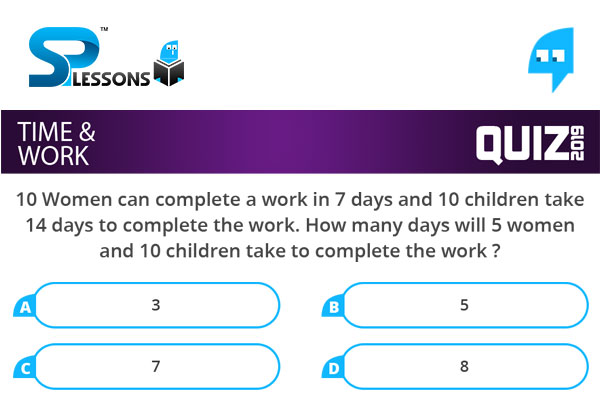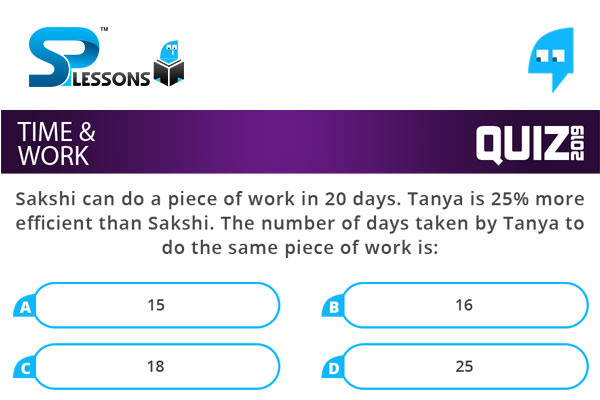 Introduction
Introduction
Time and Work is one of important topic in Quantitative Aptitude Section. In Time and Work – Quiz 3 article candidates can find a question with an answer. By solving this question candidates can improve and maintain, speed, and accuracy in the exams. Time and Work – Quiz 3 questions are very useful for different exams such as IBPS PO, Clerk, SSC CGL, SBI PO, NIACL Assistant, NICL AO, IBPS SO, RRB, Railways, Civil Services etc.
 Q1
Q1
10 women can complete a work in 7 days and 10 children take 14 days to complete the work. How many days will 5 women and 10 children take to complete the work?
- A. 3
B. 5
C. 7
D. 8
1 woman's 1 day's work = [latex]\frac{1}{70}[/latex]
1 child's 1 day's work = [latex]\frac{1}{140}[/latex]
(5 women + 10 children)'s day's work = ([latex]\frac{5}{70}[/latex] + [latex]\frac{10}{140}[/latex]) = ([latex]\frac{1}{14}[/latex] + [latex]\frac{1}{14}[/latex]) = [latex]\frac{1}{7}[/latex]
5 women and 10 children will complete the work in 7 days.
 Q2
Q2
X and Y can do a piece of work in 20 days and 12 days respectively. X started the work alone and then after 4 days Y joined him till the completion of the work. How long did the work last?
- A. 6 days
B. 10 days
C. 15 days
D. 20 days
Work done by X in 4 days = ([latex]\frac{1}{20} \times 4[/latex]) = [latex]\frac{1}{5}[/latex]
Remaining work = ( 1 - [latex]\frac{1}{20}[/latex]) = [latex]\frac{4}{5}[/latex]
(X + Y)'s 1 day's work = ([latex]\frac{1}{20}[/latex] + [latex]\frac{1}{12}[/latex]) = [latex]\frac{8}{60}[/latex] = [latex]\frac{2}{15}[/latex]
Now, [latex]\frac{2}{15}[/latex] work is done by X and Y in 1 day.
So, [latex]\frac{4}{5}[/latex] work will be done by X and Y in ([latex]\frac{15}{2}[/latex][latex]\frac{4}{5}[/latex]) = 6 days
Hence, total time taken = (6 + 4) days = 10 days.
 Q3
Q3
A is 30% more efficient than B. How much time will they, working together, take to complete a job which A alone could have done in 23 days?
- A. 11 days
B. 13 days
C. 25 days
D. 18 days
Ratio of times taken by A and B = 100 : 130 = 10 : 13.
Suppose B takes x days to do the work.
Then, 10 : 13 :: 23 : x [latex]\Rightarrow x = \frac{23 \times 13}{10} \Rightarrow x = \frac{299}{10}[/latex]
A's 1 day's work = [latex]\frac{1}{23}[/latex];
B's 1 day's work = [latex]\frac{10}{299}[/latex];
(A + B)'s 1 day's work = ([latex]\frac{1}{23}[/latex] + [latex]\frac{10}{299}[/latex]) = [latex]\frac{23}{299}[/latex] = [latex]\frac{1}{13}[/latex]
Therefore, A and B together can complete the work in 13 days.
 Q4
Q4
Sakshi can do a piece of work in 20 days. Tanya is 25% more efficient than Sakshi. The number of days taken by Tanya to do the same piece of work is:
- A. 15
B. 16
C. 18
D. 25
Ratio of times taken by Sakshi and Tanya = 125 : 100 = 5 : 4.
Suppose Tanya takes x days to do the work.
5 : 4 :: 20 : x [latex]\Rightarrow \frac{4 \times 20}{5}[/latex]
x = 16 days.
[latex]\Rightarrow[/latex] Hence, Tanya takes 16 days to complete the work.
 Q5
Q5
A, B and C can complete a piece of work in 24, 6 and 12 days respectively. Working together, they will complete the same work in:
- A. 1/24 days
B. 7/24 days
C. 337 days
D. 4 days
If A can do a piece of work in n days, then A's 1 day's work = [latex]\frac{1}{n}[/latex]
(A + B + C)'s 1 day's work = ([latex]\frac{1}{24} + \frac{1}{6} + \frac{1}{12}[/latex]) = [latex]\frac{7}{24}[/latex] days








